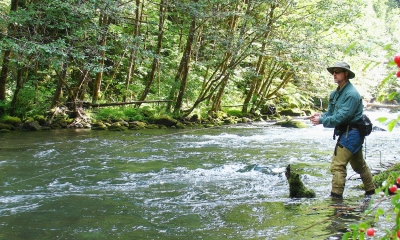
Avoid "accidental" poaching: Know your target
"I was out hunting near a reserve, and I shot a white-tailed deer. I didn’t know it was a white-tailed deer. The rules don’t say what kind of deer to hunt, they just say a deer, and I shot a deer, but I guess it’s a white-tail. What do I do now?"
"Do I have to turn myself in to OSP?" -- recent call to ODFW

The answer is: Yes. Turn yourself in to OSP.
Read about the importance of identifying your target to avoid accidentally poaching a deer, or harming other hunters, animals or property.
Don't let frustration lead to a mistake
It’s a common feeling of frustration and desperation when the final day of the hunt season rolls around, and you haven’t bagged your animal. But be the wise hunter in the woods. Always identify your target to be sure that the buck you think you’re shooting at doesn’t turn out to be someone’s Llama wandering around lost from the Pacific Crest Trail. Sound silly? There are many accidents every year because of careless shooting practices.
According to ODFW Statewide Hunter Education Coordinator Jered Goodwin, it’s not only a good practice to keep on the right side of wildlife laws, but it’s an imperative in maintaining safety. When you hunt, you shoulder more than a gun or bow. You shoulder the responsibility to be safe and to keep those around you safe. Goodwin has some sage advice from years of hunting and teaching others the craft.
“Make sure you understand the rules and regulations of the specific area as well as the species you are hunting,” he said. “Understand what your target is, what is behind your target, next to it and in front of it.”
To assist in staying on the right side of the legal lines, you can review tools in identifying animals, along with practice quizzes on the myODFW website.
How to identify your target before your shoot
- Identify the species: Learn the differences between white-tailed, black-tailed and mule deer. Here's an excellent video.
- Learn about differences in fish and marine mammals so that you catch and keep the ones that are legal, and avoid or toss back the ones that aren’t. You can learn about fish and marine species by studying the identification charts in the regulations book or go to the fish species page.
- Study the backdrop to your shot. Your bullet or arrow may hit your target and stop, or it may go past or through your target. If either of those happens, you risk injuring or killing an animal standing behind your target. You can even mistakenly hit another person, or destroy property.
Goodwin can tell you from experience that shots fired from below at an animal on a ridge can travel beyond that animal and into an area not visible from your vantage point. And that moving brush might be the deer you’re tracking- or it might be someone else tracking the same deer. Anyone who’s read the book “Blood on the Leaves,” (C 2015, Lyons Press, Slings, VanDurme, Byers) will learn the inside details of real hunting accident investigations, and lessons in hunter safety.
- If you are inexperienced, you can -- and should -- turn to online tools at myODFW.com.
- If you are a youth hunter, learn the finer points by attending a hunter education course. In the coursework, you will learn how to be sure you hit the animal you have a tag for, and leave the tempting one that isn’t the correct species, out in the forest where it belongs. And if you are an adult learning the craft of hunting or fishing, be assured that there are tips and tools for you as well. Here is a schedule of upcoming classes that will build your confidence and help you avoid senselessly killing the wrong animal, and then having to make an uncomfortable call to OSP.
Final words of advice from that Stop Poaching campaign: Always carry the regulation book with you when you hunt or fish. Leave it in the glovebox or the tackle box or your backpack, but have it for easy reference. And for your convenience, the 2021 edition is just hitting sporting goods stores, so stop in to Bi Mart and pick up a copy. Or two. You never know when you’ll need it, but you will.
Yvonne Shaw is the ODFW Stop Poaching Campaign coordinator.
Photo: Columbia white-tailed deer. Photo by Don Whittaker.

